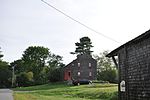Wolfe's Neck Woods State Park
1969 establishments in MaineFreeport, MaineHiking trails in MaineProtected areas established in 1969Protected areas of Cumberland County, Maine ... and 2 more
State parks of MaineUse mdy dates from July 2021

Wolfe's Neck Woods State Park is a public recreation area located on Casco Bay on the southeastern side of Freeport, Maine. The state park occupies 244 acres (99 ha) on a narrow peninsula, Wolfe's Neck, that runs between Casco Bay and the Harraseeket River. It includes white pine and hemlock forests, salt marsh estuary, and rocky shore. The park is managed by the Maine Department of Agriculture, Conservation and Forestry.
Excerpt from the Wikipedia article Wolfe's Neck Woods State Park (License: CC BY-SA 3.0, Authors, Images).Wolfe's Neck Woods State Park
Wolf Neck Road,
Geographical coordinates (GPS) Address Nearby Places Show on map
Geographical coordinates (GPS)
| Latitude | Longitude |
|---|---|
| N 43.825823 ° | E -70.08557 ° |
Address
Wolf Neck Road 426
04032
Maine, United States
Open on Google Maps









